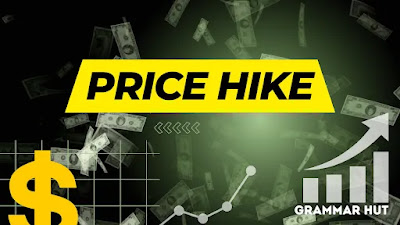Price Hike Paragraph
Price Hike
Price hike is a phenomenon that occurs when the prices of goods and services increase over a certain period. This may be due to a number of factors, including changes in demand and supply, inflation, or changes in government policies. A price hike affects consumers as it results in higher prices for goods and services, which ultimately leads to a decrease in purchasing power. Businesses, on the other hand, may benefit from a price hike as they are able to increase their profits.
One of the main reasons for a price hike is inflation. Inflation is the rise in the general price level of goods and services in an economy over time. When inflation occurs, the purchasing power of consumers decreases, which leads to a decrease in demand for goods and services. In order to maintain their profits, businesses may increase their prices to compensate for the decrease in demand. Inflation may be caused by a number of factors, including an increase in the money supply, changes in interest rates, or a decrease in the supply of goods and services.
Another factor that can contribute to a price hike is changes in demand and supply. When the demand for a certain product or service increases, the price of that product or service will also increase. This is because businesses are able to charge more for a product or service that is in high demand. Similarly, when the supply of a certain product or service decreases, the price of that product or service will also increase. This is because businesses are able to charge more for a product or service that is in short supply.
Changes in government policies can also contribute to a price hike. For example, if the government increases taxes on a certain product or service, businesses may increase their prices to offset the increase in taxes. Similarly, if the government introduces regulations that increase the cost of production for businesses, they may increase their prices to cover the additional costs.
A price hike can have a number of negative effects on consumers. Firstly, it decreases the purchasing power of consumers, as they are required to pay more for goods and services. This can result in a decrease in the standard of living for consumers. Secondly, a price hike can lead to inflation, as businesses increase their prices to maintain their profits. This can have a ripple effect throughout the economy, as the cost of goods and services increase, and consumers are required to pay more for basic necessities such as food and housing. Finally, a price hike can lead to a decrease in demand for goods and services, as consumers are less able to afford them.
Download Price Hike Paragraph in PDF File
Businesses may benefit from a price hike as they are able to increase their profits. This is because they are able to charge more for their goods and services, which results in an increase in revenue. This increase in revenue may be used to invest in new products or services, or to expand the business. However, a price hike may also have negative effects on businesses. If the price hike leads to a decrease in demand for goods and services, businesses may experience a decrease in revenue. This may result in a decrease in profits and may also lead to layoffs and business closures.
In conclusion, a price hike is a phenomenon that occurs when the prices of goods and services increase over a certain period. It may be caused by a number of factors, including inflation, changes in demand and supply, or changes in government policies. A price hike can have a number of negative effects on consumers, including a decrease in purchasing power, inflation, and a decrease in demand for goods and services. However, businesses may benefit from a price hike as they are able to increase their profits. It is important for governments and businesses to carefully consider the impact of a price hike on consumers and the economy as a whole, and to take steps to mitigate any negative effects.


Comments